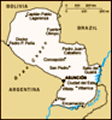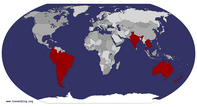Advertisement
Published: April 24th 2013
We didn´t know much about Paraguay before we arrived. Most people travelling round seem to miss it off their itineries and guidebooks don´t really list it as being a tourist hotspot. When chatting to a taxi driver in North Uruguay, we told him we were going there and he laughed through his thick handlebar moustache, peered out from under his beret and told us in spanish, barely recognisable due to a strong accent, that Paraguay was ´very rustic´.
Well, we were intrigued, and so, leaving the small town of Iguazú and countryside of Argentina, we crossed through Brazil and into Paraguay, arriving in Ciudad del Este, famously known as the blackmarket shopping capital of South America, where we were greeted by ten lanes of solid traffic, largely consisting of Brazilian shoppers hopping over the border in expensive blacked out cars to pick up a bargain, intermingled with a fair few Paraguayan vehicles heading out over the border carrying who knows what. All in all, it was hectic, smelly and chaotic. That was until we got into one of the malls to try and change some money and get some food, where white polished tiles stretched from floor to ceiling and
shops sold all and sundry. It was a bit of a bizarre place and probably not the safest to be hanging around outside the shopping districts, and so not really needing to buy any electronic goods, or designer clothes, or indeed machine guns, we weren´t too keen to stick around, and soon made our way to the bus station to head somewhere a bit less hectic.
Following the Paraguay-Argentine border, we got on a rickety bus that managed to take nearly six hours to complete what should have been a fairly painless journey, had it not had to drive around the city twenty times trying to fill the bus before leaving. On board entertainment was provided free of charge by several small parties of youths who insisted on all playing different things approximating to music out loud on their smart phones producing a rather painful cacophony not disimilar to that found on a London Underground Train heading east on the Jubilee line on a Friday night. All in all, we were relieved to be arriving in Encarnación in South Paraguay, where we had a bite to eat and found a traditional bus station style hotel (think prison but with
thin walls and no security) to hole up for a couple of nights.
We had forgotten that many cities in South America completely shut down on a Sunday and this was the case in Encarnación, with all shutters down the following day. Fortunately there were a few restaurants open and we also discovered one of the ´national dishes´, chipa. Sold on all street corners, chipa looks like bread, but turns out to be a meal in itself, since the dough is mixed with eggs and cheese. When fresh and warm, it´s actually quite delicious and we certainly had a fair few cheap meals of chipa during our stay in Paraguay.
With a quiet Sunday afternoon ahead, we took a walk down to the river which divides Argentina and Paraguay. Up until a couple of years ago, the area around the river had been the ´old town´, full of delapidated buildings and markets, however a giant hydroelectric dam upstream meant that they had had to essentially increase the level of the land by about 10 feet to prevent it being swamped by the river. As a consequence, they demolished the old town in order to raise the level of
the land and built large open plazas and a road system with the intention of further developing some high-rise complexes along the waterfront (the plans were all up around town). Unfortunately they seem to have run out of money and so there is a lovely waterfront with a web of roads and footpaths, but the land inbetween all of this has largely been allowed to go to fallow and has become a large expanse of wasteland with no ongoing building works. Fortunately all is not lost since at one end of the riverside space they did build a small sandy riverside beach and next to this was a large field which whilst we were there was used for a local kite festival with large numbers of people turning out to fly kites of all shapes and sizes - not a bad way to spend a Sunday afternoon.
That night, all chaos broke loose in the streets as an election rally for the upcoming presidential elections pretty much brought the city to a stand still. It seems that the Paraguayan way of canvassing for votes is somewhat different from that which we're used to back home. The streets, which had
been dead just a couple of hours before, came alive with hundreds of vehicles, decorated with flags and with people hanging out of windows and sunroofs, all honking horns, playing loud music from speakers out of their open boot and generally moving slower than a funeral cortege in reverse. And as if this impromptu road congestion with accompanying noise pollution wasn't enough to make you vote for the party, supporters also threw firecrackers at passers by in order to seal the deal. It was certainly an unusual way to try and persuade you that they had the best candidate for the job.
Having escaped the previous evening's entertainment with only mild tinnitus, the next day we decided to take a trip out of the city and travelled by bus out of town to the Jesuit ruins of Trinidad, one of the best preserved missions in the country. Built in the 17th Century and abandoned less than a hundred years later when the Jesuits were kicked out of Paraguay by the Spanish, the complex of churches and houses were in ruins but still impressive and enjoyable to walk around. Back home, we spent a final night in Encarnación before another
long and bumpy bus ride heading to Asunción the next day.
As far as capital cities go, Asunción was quite pleasant. There wasn't a whole lot to actually do there, but we did visit the building where Paraguay became the first Spanish colony in Latin America to sign a declaration of independence, only to install a dictator with more than a modicum of paranoia, who proceeded to instruct the demolition of all the lovely colonial buildings in favour of those that were only one storey high so that he could see what was going on around the city (he also had his mother killed and had anyone who paused for too long outside the palace shot). Now, in the absence of dictators, the city seems a lot calmer (except for the evening rallies, which were, quite frankly, bedlam), with big open plazas, a few nice old buildings and a great restaurant that served hummus and cruditees, thereby keeping Emma happy. We also visited South America´s first train station museum at Estación San Francisco in one of Asunción´s main squares, which largely built and furnished by the British, could have actually been in middle England were it not for the
Spanish annotations alongside the British parts of engines and station equipment.
From Asunción, we made the mistake of catching a night bus out of the city. Supposedly leaving at eight o'clock, we were still in the city a few hours later. With the election only a day away, we had managed to get caught up in the mother of all election rallies, and so the start of our journey to Bolivia did not begin well. Things continued at a snail pace as we finally left civilization and started out across the Chaco, stopping first for police to do random checks and terrorise some poor young man on board, then to assist a random bus broken down in the middle of the desert, and then for us all to go and get our exit stamp at the last Paraguayan border post. Our Paraguay trip did not end with a stamp in our passport however since we still had an army checkpoint to get through where we were all removed from the bus, ordered to pick up our bags and stand in, what from a distance, could not be distinguishable from a line-up for a firing squad, whilst everyone's bags were
completely unpacked one by one and we were questioned as to our reasons for coming/going/breathing by some rather unfriendly gun-wielding men in combats. The whole process, conducted at dawn, in the middle of a desert, surrounded by cacti, was most surreal, but fortunately, after a prolonged period of time, everyone was allowed to board the bus again and we were on our way, that was until we reached Paraguay's customs, where the process was repeated, albeit by some less scary and much less thorough individuals who did a cursory check of luggage and passports, accurately gaged the mood of everyone on board, and then let us continue on our way.
We did get to Bolivia eventually. It took twenty-four long and painful hours, but we arrived in Santa Cruz the following evening.
Tallies Number of vegetarian meals that have turned out to contain meat - lots. (Who knew pasta arrabiatta would contain bacon or that a set vegetarian meal would feature chicken as the main ingredient)
Number of times electrocuted by the shower - 1 (Chris affirms it´s not a mistake you make twice)
Number of random police/army checkpoints across the Chaco through Paraguay and
Bolivia: Far too many.
Number of stamps in Emma's passport - 70 (including a multitude of whole-page visas)
Number of free pages in Emma's passport - 0
Chances of Emma having to get a new passport at a British Embassy in a random South American country owing to lack of space and officious border control personel - we're taking bets, but it's starting to look more likely.
Alternatively, how much it will cost for border controls to find a bit of previously undiscovered space in Emma's passport - we'll let you know...
Advertisement
Tot: 0.134s; Tpl: 0.014s; cc: 10; qc: 48; dbt: 0.0519s; 1; m:domysql w:travelblog (10.17.0.13); sld: 1;
; mem: 1.2mb
























